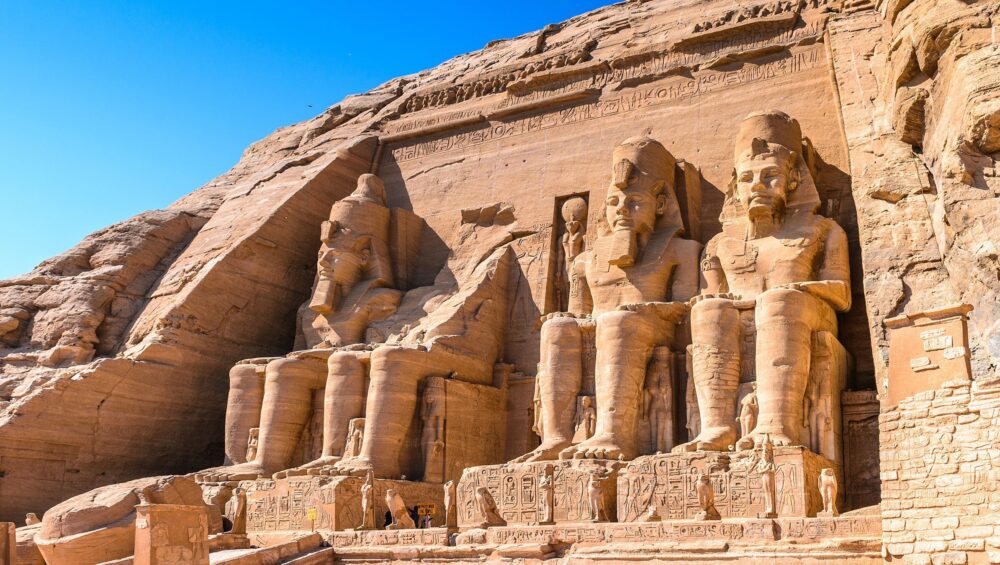The Abu Simbel temples, carved into a massive sandstone cliff along the shores of Lake Nasser south of Aswan, are among the most iconic landmarks in Egypt. Built by Pharaoh Ramesses II during the height of the New Kingdom, these awe-inspiring temples were designed to project the power of the Egyptian Empire and mark its southern border with Nubia.
Uncover the magic of Abu Simbel on unforgettable Aswan day tours! Witness the grandeur of ancient Egypt’s temples while enjoying seamless transportation and expert guides. Book your adventure today and make your Aswan experience extraordinary!
The Purpose and Grandeur of Abu Simbel
The Abu Simbel temples were not just religious sites but also symbols of Egyptian strength and dominance. The larger temple features four colossal statues of Ramesses II at its entrance, making it a monumental declaration of the pharaoh’s might. The intricate carvings inside showcase some of the finest artistic achievements of ancient Egypt, leaving visitors in awe of their grandeur.
The Rediscovery of Abu Simbel
For centuries, the Abu Simbel temples lay hidden beneath desert sands, isolated from civilization. In 1813, Swiss explorer Johann Ludwig Burckhardt rediscovered the site. However, it wasn’t until 1909 that the colossal statues were fully uncovered, drawing global attention and cementing Abu Simbel as a symbol of southern Egypt’s rich heritage.
Saving Abu Simbel: A Relocation Feat
The construction of the Aswan High Dam in the 1960s posed a significant threat to the Abu Simbel temples, as the rising waters of Lake Nasser would have submerged the site. To preserve these historic wonders, an international team undertook an extraordinary effort to relocate them.
In 1968, the temples were meticulously dismantled into pieces weighing between 3 and 20 tons and moved 180 meters west and 64 meters above their original location. This ambitious project, which took over five years to complete, ensured that the Abu Simbel temples would remain a part of Egypt’s legacy for future generations.
Exploring the Abu Simbel Temples
The Abu Simbel complex consists of two magnificent temples:
The Great Temple
The Great Temple, dedicated to Amun, Rahorakti, Ptah, and Ramesses II, is the larger of the two. Its construction took approximately 20 years and remains one of Ramesses II’s most impressive achievements. Four towering statues of the pharaoh, each 20 meters high, guard the temple’s entrance.
Inside, a series of grand halls and chambers celebrate the king and his family, with hieroglyphs commemorating his victory at the Battle of Kadesh. The temple’s innermost chamber, the Holy of Holies, is particularly remarkable. It remains dark throughout the year, except on two specific days when sunlight penetrates the sanctuary—a testament to ancient Egyptians’ mastery of astronomy and architecture.
The Lesser Temple
The Lesser Temple, dedicated to the goddess Hathor and Queen Nefertari, is smaller yet equally captivating. Its façade features six statues, with two groups of figures flanking a central doorway. This temple honors the queen and showcases the pharaoh’s devotion to her.
The Sun Alignment Phenomenon
One of the most astonishing features of the Abu Simbel temples is the biannual sun alignment in the Great Temple. On February 22 and October 22, sunlight illuminates the statues of Ramesses II and the gods Amun and Rahorakti in the sanctuary. The fourth statue, representing Ptah, remains in shadow as a symbol of the underworld.
These dates, believed to mark Ramesses II’s coronation and birthday, have aligned precisely for over 3,200 years, highlighting the advanced scientific knowledge of ancient Egypt.
Experience Abu Simbel’s wonders on top-rated Aswan day tours.
Visiting Abu Simbel
Reaching Abu Simbel is an unforgettable journey. Most travelers opt for a short flight from Aswan, while others experience its magic as part of a Lake Nasser cruise. Viewing the temples at sunrise or under the moonlight offers a unique and ethereal perspective.
Whether seen from the water or explored up close, the Abu Simbel temples provide an unparalleled glimpse into the grandeur of ancient Egypt. A visit here is not just a journey through history but an encounter with the ingenuity and artistic brilliance of one of the world’s greatest civilizations.
Plan your trip to the Abu Simbel temples and witness this timeless masterpiece that continues to inspire awe and admiration across the globe.
Embark on a journey of a lifetime with our Egypt tour packages and luxury Nile cruise experiences. Sail the majestic Nile and explore iconic landmarks like Abu Simbel, all with the finest accommodations and expert-guided tours. Reserve your dream vacation now!




